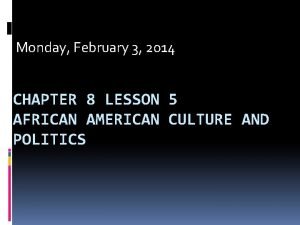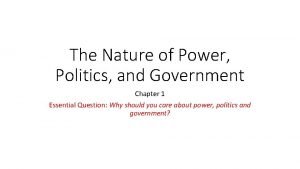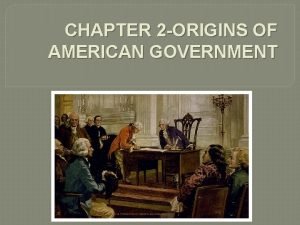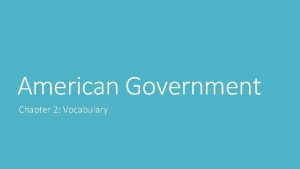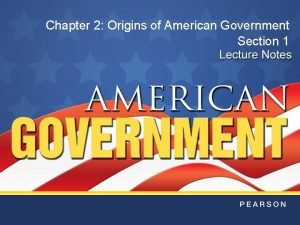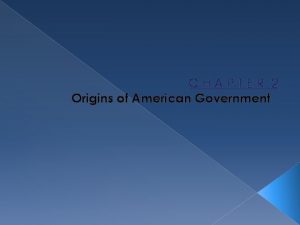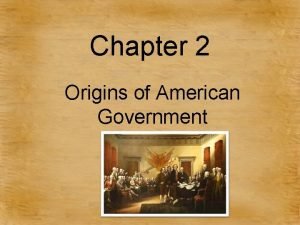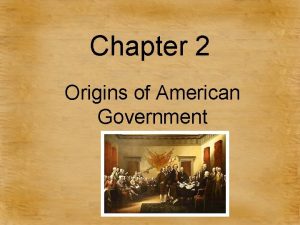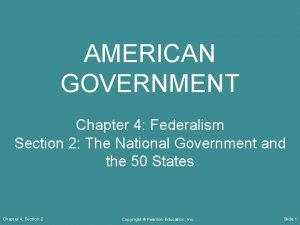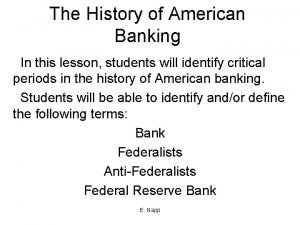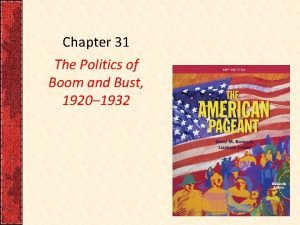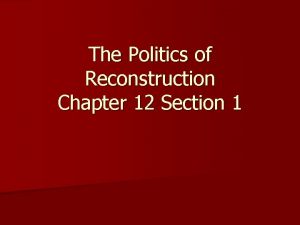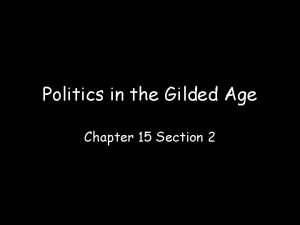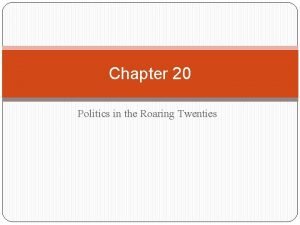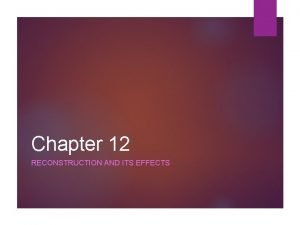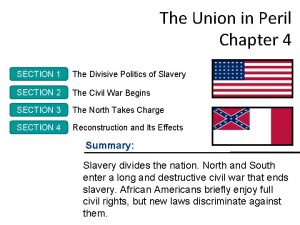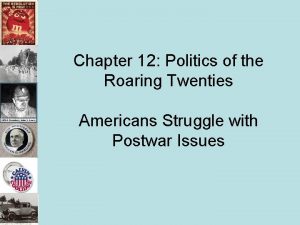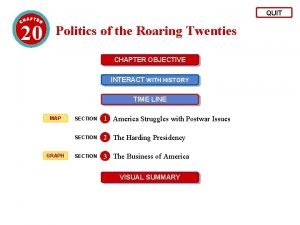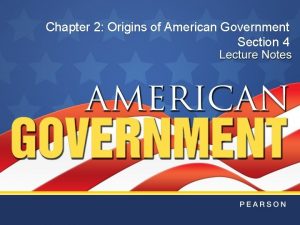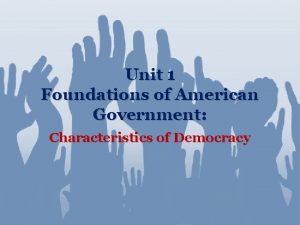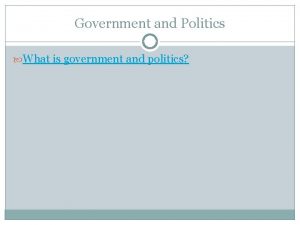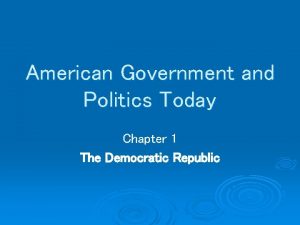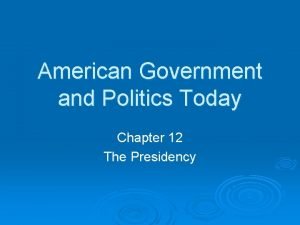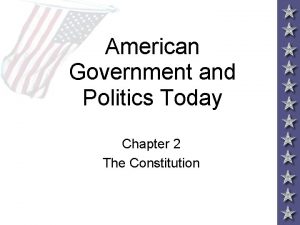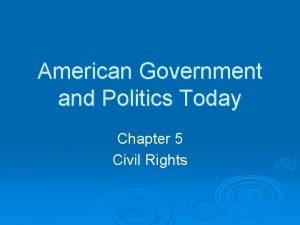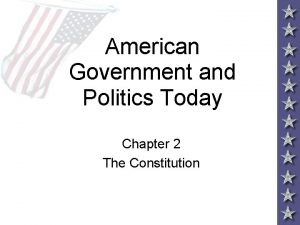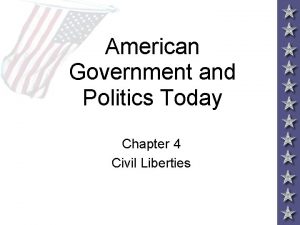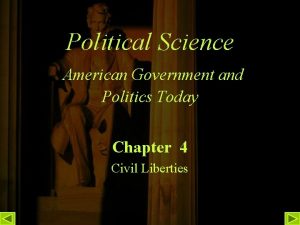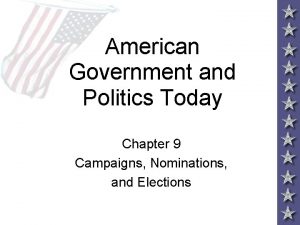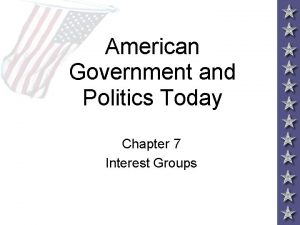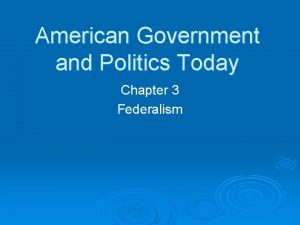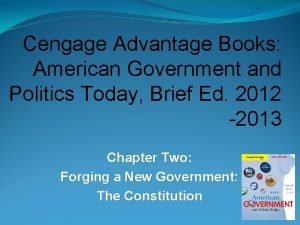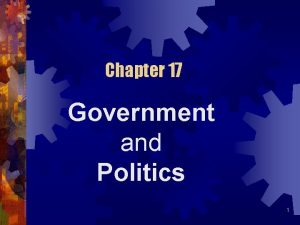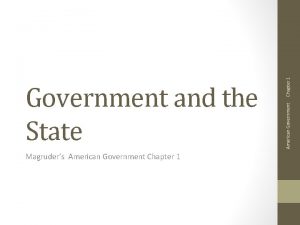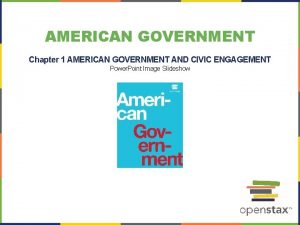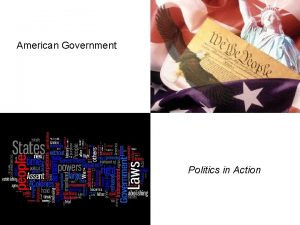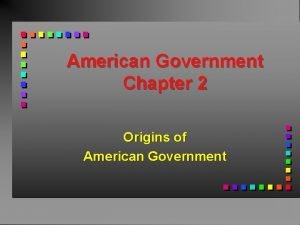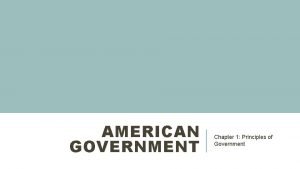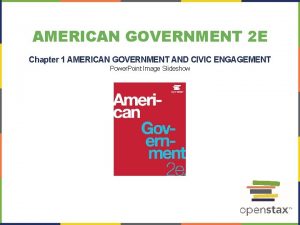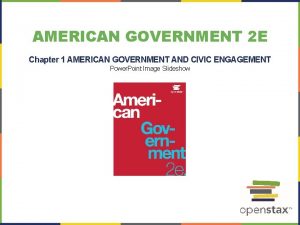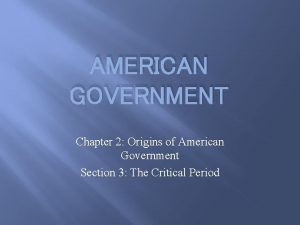American Government and Politics Today Chapter 2 The































- Slides: 31

American Government and Politics Today Chapter 2 The Constitution

I. English Pol Heritage Colonists sense of Freedom Limited Gov’t from Magna Carta 1215 Petition of Right 1628 English Bill of Rights 1688 Believed in Representative Gov’t modeled after Parliament F. John Locke – Natural Law and Social Contract Theory A. B. C. D. E.

II. Gov’t in the Colonies A. Today’s system comes from colonies B. Written plans were key - ? ? ? C. Elected assemblies established Representative Gov’t D. Separation of Powers

III. On Their Own A. Allowed limited self Gov’t B. French and Indian War leads to tightened control and reparations II. Harsh treatment created unity A. Petitions and Committees of Correspondence B. First Continental Congress C. Second Continental Congress

III. Independence A. Common Sense B. The Declaration of 1776 A. Three Parts 1. Purpose (Thesis) 2. List of Complaints (body) 3. Determination to Separate (Conclusion) C. Set Fourth principals of a new gov’t

E. 1776 Ten States have constitutions that express 1. 2. 3. Consent of Governed Limited Gov’t Protection of Indy Rights

https: //www. youtube. com/watch? v=b 5 Vqy. CQV 1 Tg

I. Gov’t under the Articles I. Unicameral Congress w/ limited powers II. 1 State = 1 vote III. No Exec IV. Weak Judicial Branch

II. Weaknesses in the Articles I. No Revenue / No … II. 100% approval on Amend III. No Exec leads to no enforcement IV. State court interpret Nat’l Law

III. Achievements of the Articles I. Western Development II. Signed Treaty w/ England III. Set up departments which would later become Pres’s cabinet

IV. Need for Strength I. Gov’t’s debt left soldiers unpaid II. Shay’s Rebellion III. 1786 Annapolis Convention

I. The Convention Begins I. Experience among signers II. Meetings in Secret III. Throw out Articles and start over

II. Decisions and Compromises I. The Virginia Plan A. Concentrated power in a lower house that was to choose the executive. B. Major weakness: representation was strictly by population, to the disadvantage of the small states. II. New Jersey Plan A. A one-state, one vote plan that would have created a relatively weak central government. Again, the executive was to be elected by the Congress.

III. Connecticut Compromise A. Compromise between more populous states, which advocated representation based on population and the small states, which advocated representation equal for each state. B. Also known as the Connecticut Plan, this provided for a bicameral legislature with one house based on population, the other with equal representation for each state. In this plan, Congress did not choose the president.

IV. V. VII. 3/5 ths Compromise Commerce & Slave Trade Compromise Dealing by not Dealing Other Compromises

III. Ratification I. Accept or Reject II. Federalists III. Anti-Federalists IV. Adding a Bill of Rights V. 1789 New Gov’t meets in NY

Working Toward the Final Agreement I. The Madisonian Model A. Separation of Powers. The legislative, executive, and judicial powers to be independent of each other B. Checks and Balances. Government had considerably more power than under the Articles of Confederation. However, these men were distrustful of those who would hold this power and of the people who would select the governmental officials.

Working Toward the Final Agreement (cont. ) – An Electoral College meant that the president was not to be chosen by Congress, but not by a popular vote either.

The Final Document – A summary of the results: popular sovereignty, a republican government, a limited government, separation of powers, and a federal system where both the national and the state governments each had their own sphere of influence.

Ratification – The Federalist Papers An attempt to persuade the public to support the new form of government. • Federalist #10 and Federalist #51 provide an excellent view of James Madison’s political theory concerning human nature. •

The March to the Finish The vote by the Virginia ratification convention was essential and somewhat close. II. The New York vote was even closer and put the Constitution “over the top. ” III. At this point, North Carolina and Rhode Island had little choice but to join. I.


Support for the New Constitution 1. 2. 3. Beard’s Thesis. Historian Charles Beard argued that the Constitution was put through by an undemocratic elite intent on the protection of property. State Ratifying Conventions. These conventions were elected by a strikingly small part of the total population. Support Was Probably Widespread. Still, the defense of property was a value that was by no means limited to the elite. The belief that the government under the Articles was dangerously weak was widespread.

The Bill of Rights A. A “Bill of Limits. ” The package was assembled by Madison, who culled through almost two hundred state suggestions. B. No explicit limits on state government powers. C. Did not apply to state governments. The restrictions only were applicable to the national government until the 14 th amendment incorporated some of these rights.

The Formal Amendment Process – Every government needs to be able to cope with any new and unforeseen problem. Any Constitutional change should, however, be taken on with extreme caution. If the process to amend the Constitution is rigorous, there should be ample time to consider the merits of such a change.


Amending the Constitution A. Although 11, 000 amendments have been considered by Congress, only 33 have been submitted to the states after being approved, and only 27 have been ratified since 1789. 1. Recent amendments have usually been accompanied by time limits for ratification. 2. The National Convention Provision. Such a convention could be called and could rewrite the entire Constitution. The product of such a convention, however, would have to be ratified by the states in the same way as any amendment.

Informal Methods of Constitutional Change I. III. IV. Congressional Legislation Presidential Action Judicial Review Interpretation, Custom, and Usage

II. Major Principles I. Federalism II. Checks & Balances III. Judicial Review – IV. Limited Gov’t – V. Popular Sovereignty. VI. Separation of Powers

Possible FRQ Ideas Why did the British place restrictions on the colonies? II. How was the term “people, ” as used in the Declaration of Independence, defined? Did the members of the Second Continental Congress mean all people? What about the rights of women? Native Americans? Slaves? I.

Possible FRQ Ideas What would have occurred if one or more of the states had rejected the Constitution? Could a single state have managed to survive outside the union of states? II. What do you believe Madison would think about interest groups in modern society? I.
 Chapter 8 lesson 5 african american culture and politics
Chapter 8 lesson 5 african american culture and politics Whose government politics populists and progressives
Whose government politics populists and progressives Ap us government and politics unit 1 study guide
Ap us government and politics unit 1 study guide The nature of power politics and government
The nature of power politics and government Chapter 2 american government
Chapter 2 american government Origins of american government vocabulary
Origins of american government vocabulary Chapter 2 origins of american government answer key
Chapter 2 origins of american government answer key Chapter 2 origins of american government worksheet answers
Chapter 2 origins of american government worksheet answers Chapter 2 lesson 1 government in colonial america answers
Chapter 2 lesson 1 government in colonial america answers Chapter 2 origins of american government
Chapter 2 origins of american government American government chapter 4
American government chapter 4 Today meeting or today's meeting
Today meeting or today's meeting Do we have class today
Do we have class today Proposal kickoff meeting agenda
Proposal kickoff meeting agenda Characteristic of fingerprint
Characteristic of fingerprint Today's lesson or today lesson
Today's lesson or today lesson Example of repitition
Example of repitition Lesson 2: the history of american banking and banking today
Lesson 2: the history of american banking and banking today Chapter 31 the politics of boom and bust
Chapter 31 the politics of boom and bust National powers
National powers Chapter 12 section 1 the politics of reconstruction
Chapter 12 section 1 the politics of reconstruction Pendleton civil service act
Pendleton civil service act Chapter 20 section 2 the harding presidency
Chapter 20 section 2 the harding presidency Chapter 12 reconstruction
Chapter 12 reconstruction Chapter 4 section 1 the divisive politics of slavery
Chapter 4 section 1 the divisive politics of slavery Chapter 15 section 3 politics in the gilded age
Chapter 15 section 3 politics in the gilded age Politics of the roaring twenties chapter 12
Politics of the roaring twenties chapter 12 Chapter 20 politics of the roaring twenties answer key
Chapter 20 politics of the roaring twenties answer key Chapter 20 politics of the roaring twenties
Chapter 20 politics of the roaring twenties Origins of american government section 4
Origins of american government section 4 Unit 1 foundations of american government
Unit 1 foundations of american government Origins of american government section 1
Origins of american government section 1
